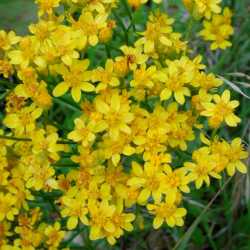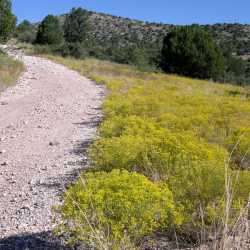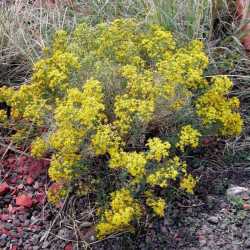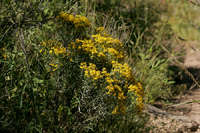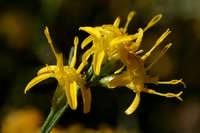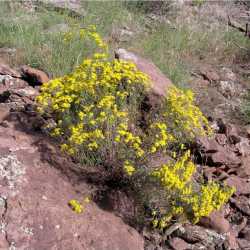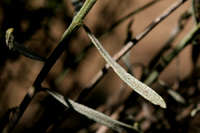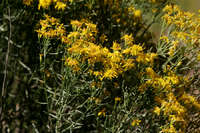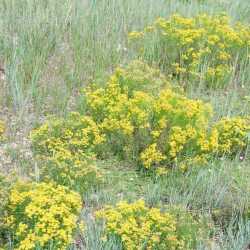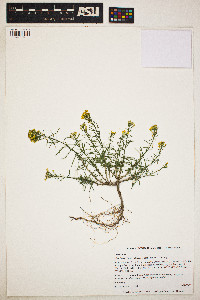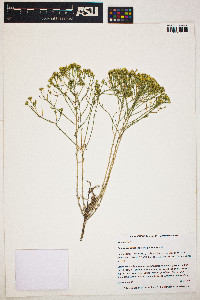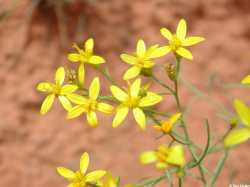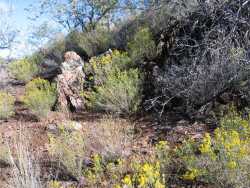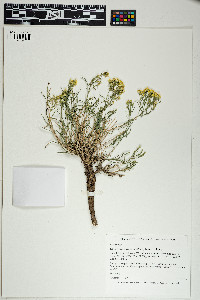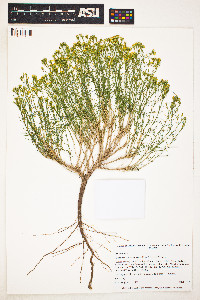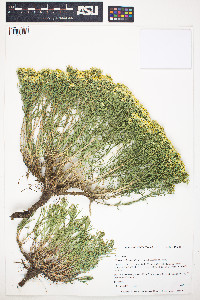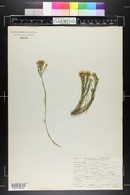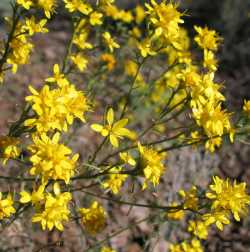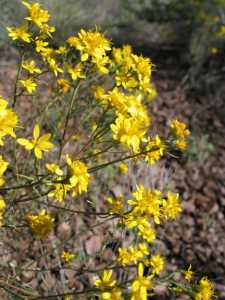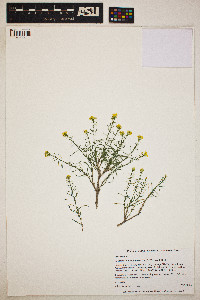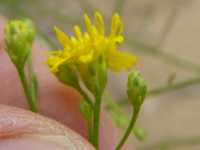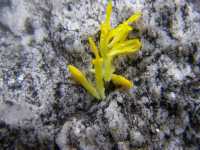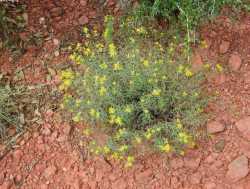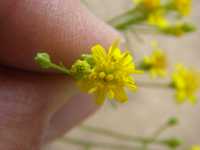|
|
|
|
Family: Asteraceae
broom snakeweed
[Gutierrezia diversifolia Greene, moreGutierrezia lepidota Greene, Gutierrezia linearifolia A.Gray, Gutierrezia linearis Rydb., Gutierrezia linoides Greene, Gutierrezia longipappa S.F. Blake, Gutierrezia sarothrae var. pomariensis S. L. Welsh, Gutierrezia tenuis Greene, Solidago sarothrae Pursh, Xanthocephalum sarothrae (Pursh) Shinners, Xanthocephalum sarothrae var. pomariense (S.L. Welsh) S.L. Welsh, Xanthocephalum tenue (Greene) Shinners] |
Subshrubs, 10-60(-100) cm. Stems minutely hispidulous. Leaves: basal and proximal absent at flowering; cauline blades 1- or 3-nerved, linear to lanceolate, sometimes filiform and fascicled, 1.5-2(-3) mm wide, little reduced distally. Heads (sessile to subsessile in compact glomerules) in dense, flat-topped, corymbiform arrays. Involucres cylindric to cuneate-campanulate, 1.5-2(-3) mm diam. Phyllary apices flat. Ray florets (2-)3-8; corollas yellow, 3-5.5 mm. Disc florets (2-)3-9 (usually bisexual and fertile, rarely functionally staminate, corollas tubular-funnelform, lobes erect to spreading or recurved, deltate). Cypselae 0.8-1.6(-2.2) mm, faces without oil cavities, densely strigoso-sericeous; pappi of 1-2 series of narrowly oblong- to ovate-lanceolate or obovate scales (readily falling, those of discs 1 / 3 - 1 / 2 corollas, shorter on rays). 2n = 8, 16, 32. Flowering Jul-Nov(-Jan). Grasslands, commonly on rocky, open slopes; 50-2900 m; Alta., Man., Sask.; Ariz., Calif., Colo., Idaho, Kans., Minn., Mont., Nebr., Nev., N.Mex., N.Y., N.Dak., Okla., Oreg., S.Dak., Tex., Utah, Wash., Wyo.; Mexico (Baja California, Baja California Sur, Chihuahua, Coahuila, Durango, Nuevo León, San Luis Potosí, Sonora, Zacatecas). Gutierrezia sarothrae is often abundant in overgrazed pastures; it is naturalized in New York.
Subshrub 1-6 dm, branched below; lvs ±linear, to 3 cm נ2 mm; heads numerous, narrow, obconic; invol 3-4 mm; rays 3-8, 2-3 mm; pappus of the disk-fls of several short but evident scales, that of the rays similar but the scales shorter and broader; 2n=8. Dry soil in open places, especially where overgrazed; Man. and w. Minn. to Kans. and Okla., w. to Wash. and Mex. July-Sept. Gleason, Henry A. & Cronquist, Arthur J. 1991. Manual of vascular plants of northeastern United States and adjacent Canada. lxxv + 910 pp. ©The New York Botanical Garden. All rights reserved. Used by permission. FNA 2006, Wiggins 1964, Benson and Darrow 1981, Heil et al 2013 Common Name: broom snakeweed Duration: Perennial Nativity: Native Lifeform: Subshrub General: Subshrubs, 10-60 cm tall, with minutely hispidulous stems. Leaves: Alternate along the stems; blades linear to lanceolate, sometimes filiform and fascicled, up to 2 mm wide, little reduced distally, 1-3 nerved. Lower portions of the stems lack leaves at time of flowering. Flowers: Flower heads small and narrow, yellow, and radiate, arranged in dense flat-topped panicles; involucres cylindric to cuneate-campanulate, 2 mm in diameter, the bracts (phyllaries) whitish with green tips, in 2-3 overlapping in 2-3 strongly graduated series; ray florets 3-8 per flower head, the laminae (ray petals) yellow, 3-6 mm long; disc flowets 3-9 per flower head, yellow. Fruits: Achenes terete, about 1 mm long, densely silky-strigulose; topped with a pappus in of scales. Ecology: Found on plains and slopes in almost any habitat from 3,000-7,000 ft (914-2134 m); flowers May-October. Distribution: Most of western N. Amer. from CAN south to s CA, east to TX; south to c MEX. Notes: Gutierrezia in our region are mostly low-growing shrubs with resinous, linear leaves lacking translucent oil glands and small flower heads with very few yellow ray and disk flowers, a pappus of erect bracts (paleae) and no chaff (bracts from the involucre subtending florets). This species very similar to G. microcephala, except for the somewhat less woody stems and larger heads with usually 3-9 ray flowers (1-2 in microcephela), 3-9 disk flowers (1-2 in microcephela) and >6 phyllaries. In the low desert it should be compared against G. serotina which has narrowly campanulate involucres and glabrous stems. Usually an indicator of overgrazed lands. Ethnobotany: Many medicinal uses, including as treatment for rheumatism, snake bites, respiratory ailments, constipation, bruises, fevers, venereal disease, sores, and headaches; also used as a sedative, an insecticide, and used ceremonially. Etymology: Gutierrezia is named for Pedro Gutierrez (Rodriguez), a 19th century Spanish noblemen and botanist, while sarothrae is from the Greek sarum, a broom. Synonyms: Gutierrezia diversifolia, G. lepidota, G. linearifolia, G. linearis, G. linoides, G. longipappa, G. pomariensis, G. tenuis, Solidago sarothrae, Xanthocephalum sarothrae, None. tenue Editor: SBuckley 2010, FSCoburn 2015, AHazelton 2017 |
|
|
|



